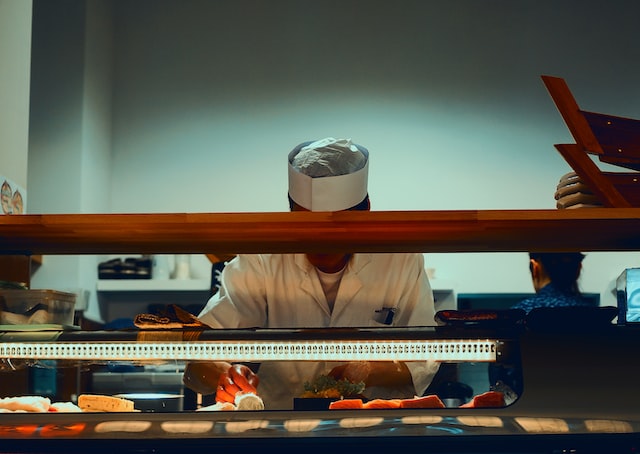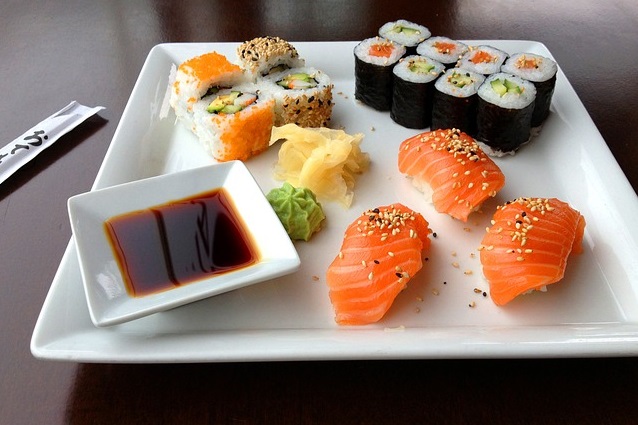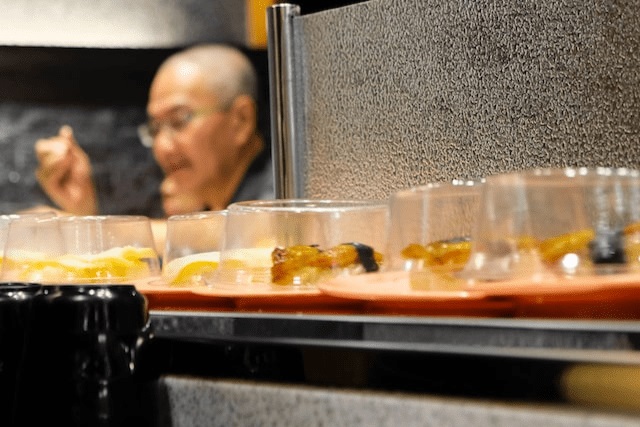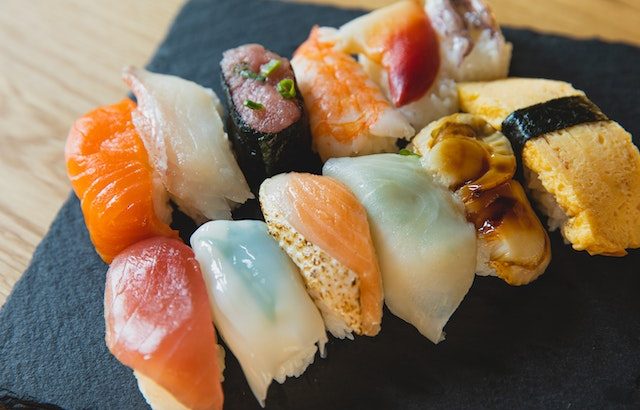The Japanese word kaitenzushi means “revolving sushi”. It refers to a fast-paced style of restaurant that serves up sushi from a large conveyor belt. They’re often called Sushi-Go-Round or sushi trains. This is because they feature plates of raw fish, seaweed, and other ingredients that whizz by on a loop. Customers then just grab what they want and eat it.
Kaitenzushi restaurants are popular and are a great way to experience some of the best dishes in Japan. Found in practically every city, they’re a popular option for both locals and tourists alike. It’s a dining experience worth trying if you ever visit Tokyo.
It’s not uncommon for non-natives, however, to feel a bit awkward when experiencing this uniquely Japanese dining setup for the first time. If you’re planning to visit Japan soon, we’ve put together a little guide about what to expect when visiting this kind of sushi joint.
What to expect at a kaitenzushi restaurant
If you’re planning to eat at a sushi-go-round restaurant, bring some cash. Most kaitenzushi restaurants, or most Japanese restaurants for that matter, don’t have credit card machines. A sushi plate costs between ¥100 and ¥500 a plate. However, with the recent rise in distribution costs and prices for raw materials, the ¥100 may be a thing of the past.
Some plates could cost around ¥800 and up, especially if they contain special cuts of fish. When eating in these joints, the more intricately designed the sushi plate is, the pricier it is. This helps you decide which plates to pick out from the conveyor built if you’re on a budget.
If it’s your first time, you can ask the server what’s popular. They’ll usually help you with the menu. In addition, if you’re interested in knowing the special for the day, it’s usually listed on the wall.

Finding a seat at a kaitenzushi restaurant
The next step is finding a seat. You can sit right next to the booth where the conveyor belts are, so you can just grab the plate you want. You can also pick a table a bit further across the restaurant, away from the conveyor belt, where you can just press a button and wait for a server to come and take your orders.
It’s common for kaitenzushi restaurants to have two types of conveyor belts. There is the faster one, which contains plates delivered straight from the kitchen to the specific table of the customer who ordered them. The slower-paced belt, on the other hand, contains sushi plates that any customer can just pick up and eat.
There will be a variety of plates on the belt — some containing sushi, some containing rice, and others containing desserts. There may also be a digital screen where you can look up more information about each dish.
Kaitenzushi plate recommendations
- If you’re new to kaitenzushi restaurants, try a plate of sushi with salmon, tuna, or eel. These are very common toppings and most restaurants serve them.
- If you’re a salmon or tuna lover, or eel tends to be too fishy for your taste, you can try a plate of salmon roe or tuna roe. These are delicious and a great introduction to sushi.
- If you’re a beginner, avoid special sushi plates like uni (sea urchin) or other more adventurous items on the menu. Some sushi varieties require an acquired taste, so beginners are better off sticking to the basics.

- Tuna and salmon are often the most common fish variety you can find in these restaurants. Price differs depending on the fish preparation method or how fat it is. Fish eggs, mackerel, and eel are also very popular options.
- If you’re not keen on fish, you can choose other options such as egg nigiri sushi, cucumber rolls, and fried tofu sushi.
Important etiquettes at a kaitenzushi restaurant
Touch only what you want to eat
The first thing you must remember is to not touch the plates— unless you plan on eating its content! Many people often make the mistake of grabbing something and then putting it back down because they changed their mind. If there’s anything appetizing you want from the belt, just go ahead and grab it. But never touch the plates otherwise.
Don’t put your plate back onto the conveyor belt
This might seem obvious, but it’s a common mistake among many first-time diners. Touching the plates can spread bacteria around and nobody wants to eat food that other diners touched, handled, and poked.
You don’t have to wait for your preferred sushi variety to appear on the belt
Not a lot of people have the patience to wait around for their preferred type of sushi to finally appear on the conveyor belt. In this case, you can just place an order by browsing the menu on the touchscreen. The dishes will then be delivered straight to you.

Stack empty plates on the side
Just like how you shouldn’t put back any plate you have touched back onto the conveyor plate, the same is true for empty ones. Keep all your empty plates to the side. This is also how the restaurants will calculate how much your bill will be.
Never take somebody else’s order
Custom orders and plates that are up for grabs are clearly indicated. So it is a huge no-no to grab a plate that another customer already requested. It’s just plain rude to do so! If there is a specific sushi plate you want to try or have seen one wheel by that seems very appetizing, use the touchscreen to place an order.
Avoid leaving leftovers
Some people often make the mistake of taking too much sushi off the conveyor belt. Leftovers on your plate are considered rude as this seems to imply that the food wasn’t good. If there is a specific type of sushi you like eating, you don’t need to grab too many plates all at once. Do it a plate at a time as they will just get refilled anyway or you can just order more if you wish to.
Kaitenzushi: A uniquely Japanese dining experience
Kaitenzushi restaurants are a great way to sample food from different regions in Japan. If you see a plate with a kanji that you recognize, just go ahead and pick it up. You might be surprised to find a taste from your hometown on the belt! Whether you just love sushi or just want to try a uniquely Japanese dining experience, kaitenzushi restaurants offer both— and that’s all the more reason to give it a go!
